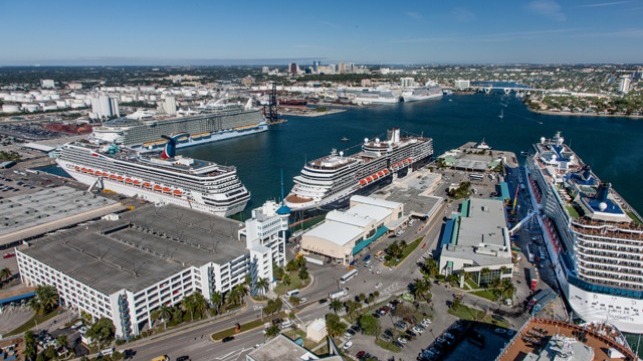Exclusive: Wells Fargo's Timothy Conder Talks Cruise Market Revenue

The cruise industry is in the midst of a strong upturn with increasing demand extending the booking curve and contributing to rising prices and earnings as well as record new ship construction orders. The Maritime Executive spoke with Tim Conder, the Senior Leisure Analyst at Wells Fargo Securities, about the factors he sees contributing to the industry’s strong  performance and the outlook for cruising. With more than 20 years of experience, Tim is a top-ranked analyst receiving multiple awards including recognized for 12 consecutive years by Institutional Investor magazine as a member of the “All-American Research Team” in the leisure sector. Known for his in-depth proprietary research, Tim has also been recognized with multiple-year stock picking and earnings estimate awards.
performance and the outlook for cruising. With more than 20 years of experience, Tim is a top-ranked analyst receiving multiple awards including recognized for 12 consecutive years by Institutional Investor magazine as a member of the “All-American Research Team” in the leisure sector. Known for his in-depth proprietary research, Tim has also been recognized with multiple-year stock picking and earnings estimate awards.
Tim, thank you for joining us. Let’s start with your overall outlook for the cruise industry?
We are very bullish on the near-term and long-term. We are very excited by the secular demographics which we believe will continue to drive the outlook. Investors are underestimating the opportunities created by the secular/demographic tailwinds; the under penetration of the market relative to vacation alternatives; the expanding geographic product offering and global sourcing; and the enhanced use of data analytics to drive revenues.
How is cruising benefiting from the changing consumer demographics?
The experience-driven consumer is not only Millennials but in my view, you are seeing the conversion from the Xers to the Boomers valuing experiences more than things. One of the industry executives recently described the consumer saying if you can Instagram it, rather than experience it digitally or virtually, it is much better.
Cruising fits perfectly into that motivation. Whether it is multi-generational cruising where the grandparents take along their children and grandchildren, or a group of college friends, a couple, or a family, that is the essence of cruising – experiences.
Also, the valuing of travel and experiences versus things is not just a U.S. phenomenon. The Europeans have been there before us. Now you are seeing China come into the equation, while the Australian market developed extremely well for the industry over the past over 10 to 20 years. This is a global trend among the developed economies that we see no signs of changing.
Are there any issues that you fear could slow the industry’s rapid development?
Some type of geopolitical turmoil would obviously impact the industry. However, while it might be a sad commentary about our times, the global populace is somewhat accepting of terrorism events such as those that we saw in Nice, Brussels, and London. Each time something like that happens, travel bookings do take a short-term pause but those pauses are becoming shorter and less.
A significant increase in frequency and or intensity of those activities we believe could cause some disruptions or some geopolitical macro event that would trigger a recession in developed economies. However, because of the secular demographic trends, I believe these companies should hold up better than they have even historically through the next recession assuming it is a more normalized recession.
Are you concerned about the number of berths entering the market due to new construction?
It is a big topic among investors that we have a lot of capacity coming out through 2022. However, the secular demographic trends are creating a lot of demand and the discipline of the industry provides strength. Management at the big companies is incentivized and paid on returns on investment capital. That is one of the reasons the industry has become much more well run and disciplined over the last several years.
Further, as the geopolitical situation gets back to normal in areas such as the Eastern Mediterranean, it could be another mitigating factor that will help manage growth even if we have a recession. Over the last two years, the industry dropped the Eastern Med with the exception of Greece, due to the unrest in Egypt, Tunisia, Istanbul and the Arab Spring movement. The Eastern Med inclusive of the Black Sea, along with the Baltic, Alaska, and Hawaii, are the industry’s most profitable itineraries generating the richest revenues on a per day basis.
How does the industry balance these new ships with the existing fleets?
When a ship hits 25 to 30 years, the big operators are looking to move it on. They look at the economics of the ship, generally considering fuel efficiency and does it have the amenities that they should be able to convert into revenue. They look at operating costs versus revenue generating ability and therefore return on the ship. They are moving the older ships on to second-tier operators, which in turn are scrapping 40 to 50-year-old ships.
IMO 2020 might also help with some of the concerns about capacity. Does it make economic sense to put a scrubber on a 45-year-old ship? Are they going to pay the higher price for low sulfur fuel or potentially accelerate some disposal of older tonnage? We have not seen a lot of hard evidence of this yet, but it is something we are thinking about for the industry.
What type of impact do you think IMO 2020 will have on the cruise industry?
IMO 2020 is going to cause a substantial decrease in demand for high sulfur fuels (HFO) and an increase for low sulfur fuels (MGO). For the 2020-2022 period, we believe you could see a net increase in fuel costs for the cruise industry because of mixing costs. Beyond that, assuming that the price of crude is stable, MGO should stabilize and potentially even drop a little as more refining capacity is added to meet the increased demand. HFO will be interesting as demand will clearly drop.
We think the cruise industry is fairly well positioned as far as being able to deal with the impact. Unlike the commercial shippers, which are business-to-business, the cruise industry, because it is consumer-facing, believes it cannot pass along costs. So they have decided to diversify. They are going to have scrubbers, some will use MGO, and then you have LNG ships coming into the equation, which will further diversify and help manage the impact of the IMO 2020 regulations.
Is the industry prepared to manage rising costs?
As we saw this spring, fuel costs and foreign exchange have gone against the industry, but despite this headwind, the demand side has further improved so that the companies have been able to offset those pressures. We believe, cost increases will not be detrimental near-term in part due to the strong demand which is creating a tailwind for the industry along with the good secular demographics. The trends will help to absorb the added capacity, but if we get a hard recession with the added capacity that will create some short-term challenges for the industry.
What is your outlook for revenue growth?
Yields in the industry have grown about 1.5 to two percent a year long-term, and that is what we would continue to look for depending on the market and the capacity going into the market. I think yields will continue to have a lot of support from onboard spend because of the different options that continue to develop at an increasing pace.
The consumer has decided what they are willing to spend for their vacation, but are they willing to spend more if the lines can demonstrate how the consumer will get more value. The industry has positioned itself creating more a la carte options. On the one hand, they are adding choices which appeal to the consumer – the opportunity to buy shore excursions, beverage and spa packages and premium restaurants – while also driving revenues. As a result, you have seen the industry’s onboard revenue go on average from 23-25 percent to 30 percent. We would expect that cruise prices will continue to rise, but the yield increases will be more driven by onboard revenues.
How are the new consumer demographics contributing to revenue growth?
Along with being experience driven, these consumers expect improved technology as seen in the uptake on wi-fi and customization of their vacations. The industry actually wants them to plan and pre-book options as they can manage and based on demand scale up or down just like they do with the ticket. Also, research shows that you tend to spend more when you pre-book and pre-pay. When you get to the ship, those pre-booked expenses are out of sight out of mind of your wallet. While you might have a total budget for your vacation, people often exceed it when you combine the advance charges and the onboard expenses. So, by creating choices and through advance bookings, net net they sell you more.
Which markets are driving the industry’s performance?
Overall, the markets are globally strong. When a market is hot, the cruise industry puts more capacity in it until it equalizes out demand and supply and then shift it elsewhere.
We are seeing that in Alaska where we just had two record years. Alaska is capacity constrained due to regulations but it is a premium market that appeals to consumers who might otherwise go to Europe. Alaska is also a bucket list item for a lot of people and with a good economy and the secular demographics, the cruise lines are adding capacity due to demand.
China capacity has been cut back but coming from a very low base, the trajectory is up and to the right. You are going to have some pretty sharp ups and downs in a very early stage growth market and that is exactly what has happened here. It is a result of distribution needing to develop and evolve from a charter model to more the traditional travel agent model and ultimately into more of a direct model.
Where are the next big opportunities that you see for cruising?
In itinerary development, the big opportunity is going to be in Asia lengthening cruises especially out of China from four to five days to more seven, 10 and ultimately 14 days around Asia.
The other development you are going to see with China is the fly/cruise market. Chinese travel a lot. We have already seen some of the cruise lines carrying groups of 200 to 400 Chinese passengers on Alaska cruises with one or two dedicated Mandarin speakers there to assist. Fly/cruise is a segment of the cruise industry that the executives are discussing, but it is developing at a much more rapid pace than envisioned by the industry leadership even two years ago. You might see a class of ships – or a brand – developed focused on the Chinese consumer but sailing everywhere but China. We believe that you could see it in the higher desire to see more unique areas such as in the Mediterranean, Baltic and Northern Europe.
In conclusion, we feel very good about the cruise industry and feel that the valuations for the group remain attractive.
Thank you, Tim!
The opinions expressed herein are the author's and not necessarily those of The Maritime Executive.
